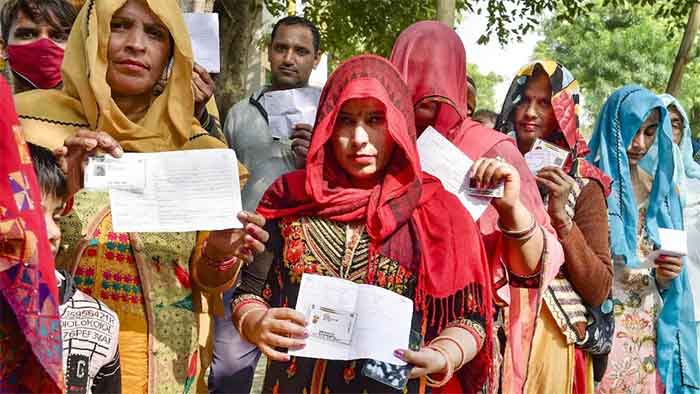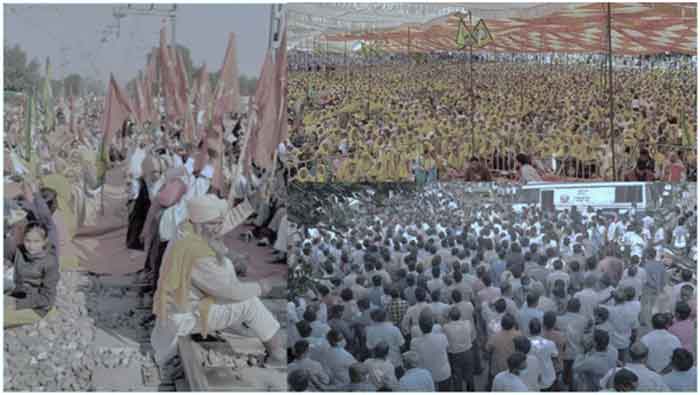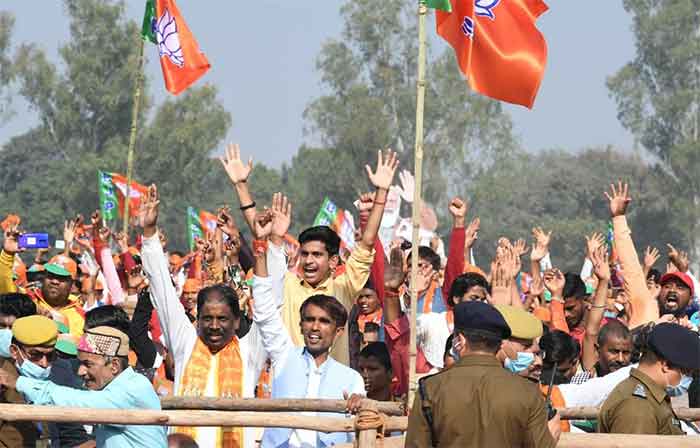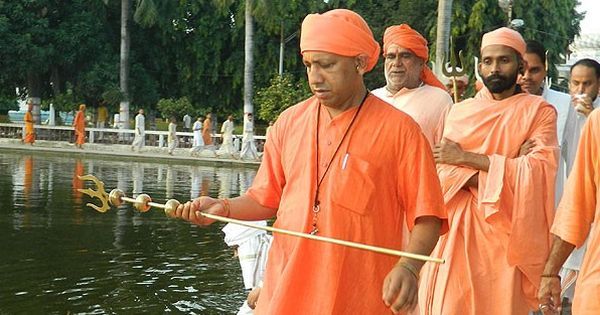
The assembly elections in five states, being held from February 10 to March 7, 2022, are bound to have an impact on both: the politics of power and the politics of ideology. The impact of these elections on the politics of power is being discussed more and more in political parties, mass media and citizens’ discourse. With the acceptance and permeation of neo-liberal economic policies, the narrative that has emerged on the political and intellectual stage of India, has almost eclipsed the sources and inspirations of the politics of ideology. The primary criterion of politics of ideology in any country would be its constitution. The ideologies of Left, Right or Centrist political parties participating in politics have to gain their legitimacy and significance by further developing and strengthening the ideology of the constitution. Only leaders and law-makers who have mastered the art of the constitution can perform this necessary task.
This is no longer the case in India. The evidence of this can be seen in the laws and policies formulated, discussed and passed in Parliament and Legislative Assemblies; and also, in the bizarre discourse of elections sending the law and policy-makers in Parliament and Legislative Assemblies. In the elections of five states, no party has even spoken of reviewing the neo-liberal policies, despite the dire economic disparity and unemployment in the manifestos of all the parties that have been released. Any election related reports, analysis or articles have not considered these elections from this perspective so far. Even in the reactions of voters appearing in newspapers and TV, the discussions about unemployment, inflation, economic inequality, development, corruption etc. have not been made in the context of neo-liberal policies. These elections in the five states too are a testimony to the fact that the making of New or Corporate India will be done by rapidly advancing and strengthening neo-liberal policies imposed on the ideology of the Constitution. Thus, the emerging corporate feudalism with New India is going to stay for a long time to come. This is the clear consequence of these elections on the politics of ideology, which one does not need to wait for the election results to understand.
Some common features of power politics can be easily characterized: The politics of power in India runs more or less on the basis of communal and caste mobilizations. Huge sums of money are spent on elections, which come from corporate funding and the wealth accumulated by parties and their leaders through political power. There are defections in all parties. All the leaders shower populist slogans and promises. There is a competitive populism on who can give what for free and the ruling parties brazenly misuse the government machinery. These elections too are no exception to all this. The list of impacts these elections will have on power politics is quite long, from the presidential election to be held in July this year to the Lok Sabha elections in 2024. The assembly elections of Uttar Pradesh (UP) are being described as the semi-finals of the 2024 Lok Sabha elections. The election results here will not only affect the politics of the opposition, but will have a deep impact on the political future of the state Chief Minister Adityanath Yogi, Prime Minister Narendra Modi and Home Minister Amit Shah. That is why all three have tried very hard to win the UP election.
In UP, BJP has entered the election campaign with the prop of communalism. The election campaign waged by the desperate BJP leadership is a campaign of openly polarizing the majority votes through the politics of hate. In the paroxysm of hate politics, by stigmatizing some Indian states in comparison to UP, it has placed its own claims of development on the one hand, and has attacked the national integrity on the other. The BJP has tied the cart of development behind the well-geared fast pace vehicle of communalism. Along with this, a campaign has been launched to publicize the rule of the previous government of UP as ‘goonda-raj’. Even though the figures of National Crime Records Bureau (NCRB) tell the truth of the rising crime in UP, and the son of the Minister of State for Home in the Central Government has been an accused of crushing four farmers under his car in broad day light, BJP is bent upon to preach Yogi-Raj as a heaven for law and order. If Kabir comes to New India, then he will be amazed to see that there is a lot of material for ‘ulatbansi’ here. There will be no limit to his astonishment when he would find that Narendra Modi, Amit Shah and Yogi Adityanath are calling the opposition, especially the leaders of SP, rioters and goons-mafia!
The BJP, in its bid to win the elections, has also done some forestalling and deft hedging. The RSS/BJP media machinery has spread a ‘novel argument’ about ever rising costs of necessary items that bearing the brunt of ‘mehngai’ in the making of New India is, in fact, patriotism. This is a permanent forestalling on the part of BJP so that inflation does not affect the votes. Spreading the election in seven phases is also the part of the forestalling. That too in such a way that a speech can be made in Saharanpur a day before the polling in Muzaffarpur-Kairana. The first two phases of elections show that reports of large number of people being dropped from the electoral rolls, and the misuse of postal ballots were not baseless. People are apprehensive that the government may have rigged the elections at the time of counting of votes.
In western UP, BJP faced a tough challenge from the opposition. The impact of the farmers movement is more visible in the western and terai areas of the state. But the farmers of central and eastern UP have also not remained unaffected by the movement and its ultimate victory. The farmers as a large group are angry with BJP. There are indications that BJP has suffered electoral losses in comparison to the last elections in the first and second phases. It has become clear by now that people have preferred concrete issues over platitudes (of development) and brotherhood/harmony over communal animosity. The devastation caused by the corona pandemic is also an important factor in UP. The Prime Minister may have tried to pin the blame of the devastation on the opposition, but it is not easy to blame those who have lost their loved ones and jobs. Young men and women, who run pillar to post for government jobs, and thrashed by police batons are angry with the government. They cannot be forever seduced by the parrot-rattle of development such as expressways, international airports, mega-cities, smart cities, beautified holy pilgrimages and even ‘Bhavya’ Ram Mandir. Despite BJP’s forestalling, ‘mehngai’ is definitely an issue, from the low class/lower middle-class people doing small permanent/temporary jobs to the daily wage labourers.
In the opposition camp, the alliance of SP-RLD and some other smaller parties supposed to be in a stronger position than BSP and Congress. Most of the minority voters seem inclined towards the SP-RLD alliance. A large number of backward voters have left BJP and joined SP in this election. That’s why the attack of Narendra Modi and Amit Shah is on the biggest alliance party SP. Dalit voters are said to be united in favour of BSP. But Mayawati’s opportunistic, money-making and pro-BJP politics has destroyed the political strength of the Dalit movement to a great extent. Hence, there seems a split in Dalit votes. Most of the Dalit voters are definitely seen standing with BSP in this election. But those who are disillusioned with BSP are with BJP and SP-RLD alliance. It seems that people have not taken Satish Mishra’s claim seriously that once again a Dalit-Brahmin unity will form the government of BSP. The strategy adopted by Congress to create a base of women voters at the time of elections is not expected to be of any great benefit in this election.
However, BJP will get the benefit of the split of the opposition votes. Apart from this, BJP has a cohesive strong cadre. The workers of RSS/BJP also make close contacts and relations with the workers of the parties which keep moving in and out of the BJP-led National Democratic Alliance (NDA). Every election is also being fought in the media including the social media. The BJP has been far ahead from other opposition parties in this venture. The spokespersons who appear in the media on behalf of parties like SP-RLD happened to be election time entries. Their identity has not been inter-linked with party’s organizational structure and policies/ideology. Whereas the BJP has a large number of permanent spokespersons. Also, an army of pro-RSS/BJP ‘political analysts’ can be found present on the channels.
The anti-incumbency wave and instability of the government are major factors in favour of Congress against BJP in Uttarakhand. However, its election machinery/campaign was not so strong. In the 2017 elections, out of 70 seats, BJP got 65 and Congress got 5 seats. Even if it is to be believed that this time there is a close fight between BJP and Congress, even then it will not be an easy task for Congress to cover such a huge gap. In Punjab, Congress has faced anti-incumbency and internal squabbles vis-à-vis other parties/alliances. The support of the peasant movement could have benefited Congress most in Punjab. But the developments such as bitterness arose during the change of leadership in the recent past, the alliance of senior leader Captain Amarinder Singh with BJP, fielding candidates on all seats by the newly formed party of farmers’ organizations, support of AAP vis-a-vis Congress by certain sections of Samyukt Kisan Morcha (SKM), and radical elements’ solidarity with AAP have snatched that advantage from the Congress.
The BJP would take advantage of this situation. That is why convicted ‘rangila’ Baba Ram Rahim has been released from jail on furlough. People think that he was out from jail to instruct his followers to vote for the Punjab Lok Congress-BJP alliance. Simultaneously, three election visits of the Prime Minister were organized by BJP. JP Nadda, the BJP president, has reminded the Sikhs of Punjab about the 1984 riots. Earlier, I had assumed that Captain, having the army background, would keep a different understanding of national security and nationalism vis-à-vis RSS/BJP. But, after leaving Congress, he has been chanting songs of Punjab security by aligning with the forces intent on fragmenting the country and society.
Needless to say, being a border state, Punjab is a very sensitive state in terms of national security as well as internal peace. It has suffered the brunt of extremism for a long time. The divisive elements are still active in the country and abroad, this is confirmed by the incidents and arrests from time to time. As a border state, the importance of Punjab for national security is only when there is complete internal peace in Punjab. But the irresponsible manner in which politicians are juggling the question of national security and internal peace of Punjab for votes in this election is quite worrying. Kejriwal and his supporters, who have aligned with the radical elements living in Punjab and abroad, are playing a dangerous game with the inner peace of Punjab in the lust of power. I have said this in the past, and there have been reports in the press that from the very beginning, radical elements abroad have used AAP as a weapon to break the traditional political power structure led by Congress-SAD in Punjab.
The direction of ‘change’ and ‘alternative’ that AAP and its supporters are rhetoring in Punjab is clearly towards a communal right-wing politics. As, under the ambit of corporate politics, campaign of ‘Narendra Modi versus the last 70 years’ has been going on indiscriminately at the Center, similarly campaign of ‘Kejriwal versus last 70 years’ can be seen in Punjab. The people have already witnessed – ‘Modi in the country, Kejriwal in Delhi’ campaign in 2014 elections. The strong voice that was raised against pro-corporate politics by the farmers’ movement, that arose out of Punjab’s womb, seems to have buried in Punjab itself. The farmers movement itself could have been the basis for proper and permanent solution of otherwise incurable diseases ranging from unemployment to drug addiction and sacrilege in Punjab. Don’t know whether the SKM leadership and its workers are aware of this loss!
Charanjit Singh Channi was made the first Dalit Chief Minister of Punjab as a compromise candidate. The Congress, albeit belatedly, announced Channi as its chief ministerial face in an attempt to woo the Dalit votes. However, the phenomenon of empowerment of Dalit society through opportunities in the education and service sector and foreign earnings have also played a role behind Channi’s elevation. Punjab has the highest number of Dalit votes, but on that front Congress is competing with AAP, SAD-BSP alliance, Samyukta Samaj Morcha and CPI-CPM.
AAP has been trying hard to take advantage of dispersion of the influence of the peasant movement in Punjab, the anti-incumbency wave, and infighting within Congress. The ‘honest’ and ‘virtuous’ Kejriwal accused Channi of being dishonest and corrupt to malign his image. AAP was also confident that it would get the urban Hindu vote in large numbers in absence of a weak BJP. But with the sudden activation of BJP, its calculation may go awry. In this election full of allegations and counter-allegations, all parties and their leaders have one thing in common – all are clamouring for the Sikh Gurus and prostrating their heads in Gurdwaras for the Guru’s blessings. Meanwhile, the exercise of taking electoral advantage of Sant Ravidas Jayanti was seen from Punjab to Varanasi in UP and Delhi. However, there is a possibility of a hung Assembly in a multi-cornered contest to be held on February 20; And President’s rule can also be imposed there.
In the 2017 assembly elections, Congress emerged as the single largest party in Goa and Manipur. The central observers of Congress did not play their role seriously in both the places. As a result, BJP formed its government in both the states. From the last election till this election, the politics of these two states has remained a quagmire of defections. In Goa, Congress has an alliance with the Goa Forward Party. Former Chief Minister late Manohar Parrikar’s son Utpal Parrikar has parted ways with BJP and contested as an independent from his father’s seat Panaji. In Goa, even the people of BJP were saying – ‘BJP has to be saved, BJP has to be defeated’. Confident of its victory but plagued by defections, Congress administered oath to its candidates in temples, churches and mosques!
Apart from Congress and BJP in Goa, the smallest state with 40 assembly seats and an electorate of 11,64,522 voters, TMC-MGP alliance, Shiv Sena-NCP alliance, Aam Aadmi Party are also in the fray. It is rightly said that here the parties/leaders were vocal and the voters were silent. It was obvious for the voters to get confused amidst the noise of so many parties and the highest ever 301 candidates in the fray.
Prime Minister Narendra Modi, coming from the RSS, who opposed the country’s independence from the British, has made a ‘wonderful’ point here that Nehru did not allow Goa’s independence for 15 years! For the first time, the voters of Goa also saw a considerable communal colour in the elections. Nearly 79 percent polling, though little less than the last election, indicates that voters were silent, but not passive. The results of the multi-cornered Goa Assembly elections are the most difficult to predict. BJP does not have a pre-poll alliance in Manipur. Congress has alliance with CPI, CPM, Forward Bloc, RSP, JD(S). In Manipur also the position of Congress is said to be stronger than that of BJP.
Mamta Banerjee came to Lucknow in support of the SP-RLD alliance. This is an important sign for power politics in the opposition camp. If BJP’s seats in UP cut to just a simple majority or even less, and the MLAs of the SP-RLD alliance do not defect to BJP in its bid to manipulate government formation, then the prospects of an anti-BJP front, without Congress, proposed by Mamta Banerjee for the 2024 Lok Sabha elections, will get strengthened. If the SP-RLD coalition forms the government, then the momentum for formation of such a front can accelerate. If Congress is unable to form governments in Uttarakhand, Goa and Manipur, and it does not perform well in Punjab as well, it will find it difficult to stop the consolidation of the opposition’s non-Congress anti-BJP front. Because in such a situation RJD, NCP, Shiv Sena, left parties may also be ready to form an anti-BJP front without Congress.
If Congress forms governments in Uttarakhand, Goa and Manipur, and performs well in Punjab, its position in opposition politics will be strengthened. But if the BJP forms an absolute majority government in UP, Congress’s position in the 2024 elections will be extremely weak. Apart from this, in states like Rajasthan, Chhattisgarh, Madhya Pradesh, Karnataka etc. where Congress has a direct fight with BJP, the latter will give a tough challenge to Congress.
(The writer associated with the socialist movement is a former teacher of Delhi University and a fellow of Indian Institute of Advanced Study, Shimla)















































